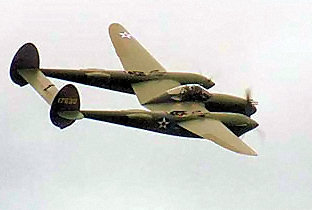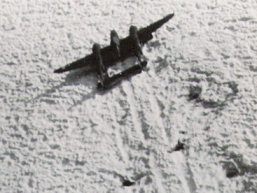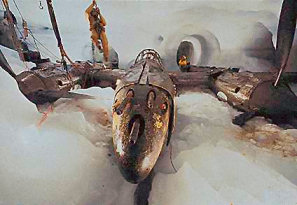skwerl-hat
One of the Regulars
- Messages
- 288
- Location
- Las Vegas Nevada

In the early days of the Second World War, Allied forces began Operation Bolero, a daring and risky effort to bring American planes to the European theater by way of secret airbases in the far north. As part of this operation, on 15 July 1942 two Boeing B-17 bombers were being escorted by six Lockheed P-38 Lightning fighters as they flew over Greenland towards Reykjavik, Iceland.
Early in the morning, the flight group encountered syrupy clouds which forced the pilots to climb over 12,000 feet to regain visibility. As the planes gained altitude, temperatures inside fell to ten degrees below zero Fahrenheit. The men in the planes tried to improvise ways to keep warm, such as rerouting the defroster into the cabin, but it did little to help. At about 7:15am, after encountering extreme numbness due to cold and continued poor visibility, the pilots decided to return to the airport they had departed from. But the weather behind them had worsened, and the men became disoriented in the severe conditions. After ninety minutes of flying blind with only intermittent radio contact, the clouds cleared sufficiently for the flight group to ascertain its position: they were over the east coast of Greenland, about two hours from the nearest airport… and they had only twenty minutes of fuel remaining. The men had no choice but to crash-land on the icecap of Greenland.
Because their tanks were already running near empty, it was decided that the smaller P-38 fighters should land first. The B-17s would follow about thirty minutes later, once their fuel had been further depleted. Pilot Brad McManus decided to make the first attempt at landing. Uncertain whether the flat expanse of whiteness below was solid ice or yielding snow, he descended with landing gears extended. He knew that if the ground was solid enough to allow the plane to land this way, he could liftoff and fly back to base once a fuel drop could be made. The other pilots watched as McManus's plane touched down gently, rolling through the thick snow at high speeds. Everything appeared to be going smoothly for the first two hundred yards or so, but the front landing gear buckled under the pressure, immediately flipping the P-38 onto its back.

Next was Robert Wilson, who had retracted his landing gears after watching McManus's attempt go awry. His plane slid smoothly across the snow on its belly, and once it stopped he leaped from the cockpit to dash almost a half mile through knee-deep snow to the overturned plane. There, he found that McManus was unhurt, having cut himself out of his parachute harness to dig his way out onto the ice. The other planes landed one by one without further incident, and the twenty-five men gathered together to pool rations and supplies. They quickly fabricated makeshift heaters using engine parts and motor oil, and began the efforts to contact Allied forces.
After three days in the freezing temperatures, one of the radio operators finally received a Morse code message from base, confirming the squadron's position and condition. Several supply drops were made, but the first two loads disappeared on the horizon when their parachutes were ensnared by the high winds on the flat expanse. The stranded pilots acted quickly when further supplies arrived, smothering the chutes before the much-needed supplies slipped away.
A dogsled team finally appeared on the horizon on the tenth day. The airmen collected their belongings from the mostly-intact planes, some of the men riddling the electronics with bullets to foil any Nazi attempts to scavenge the aircraft. Guided by the rescue team, the group of Americans trudged through knee-deep snow for hours– through a maze of zigzagging crevasses– before finally reaching the ocean's edge. The rescued airmen slept as they waited for the Coast Guard cutter to arrive later that day. Once aboard, they were treated to showers, dry clothes, and a hot meal. They had survived their crash-landing and several days stranded on a desolate ice sheet, all without so much as an injury.

The Allies were forced to abandon the wounded planes, unable to retrieve them as they slowly disappeared under drifting snow. The P-38 was a fast, powerful aircraft which was one of the most valuable Allied fighter planes of the war, and the giant B-17 flying fortresses were massively useful in the war in Europe. But as valuable as the aircraft were, limited resources prevented a successful recovery. In time, the planes became known as the Lost Squadron.
In the years following World War 2, the P-38 and B-17 airframes soon became obsolete and were decommissioned, many of them being melted down for scrap metal. But the abandoned planes of the Lost Squadron were not forgotten, and between 1977 and 1990, eleven different teams tried and failed to find and recover the aircraft. It was generally believed that they would be found in a state of near-perfect preservation, most likely buried near the surface and relatively intact. But the particularly harsh environment made any search a formidable task. Magnetometers and small radar units found nothing in the search area.
In 1988, two explorers sponsored by the Greenland Expedition Society finally found a lead. Patrick Epps and Richard Taylor led an expedition to the the ice cap which used steam to bore a hole and locate airplane parts buried under the Greenland ice. The two men found that in the forty-six years since the planes had crash-landed, an astonishing 268 feet of ice had accumulated over them, and they had been carried three miles by the drifting glacier.
The Super GopherGiven this extreme depth, the expedition's original plan to dig or blast the planes out of the ice was no longer feasible. However the men did not resign the effort, and in 1990 they returned with a contraption called the Super Gopher. This five-foot-tall, four-foot-diameter cylinder was suspended by a chain and hoist, and it had a cone-shaped tip which was wrapped in copper hot-water lines. The heat from these lines melted the ice at about two feet per hour as a pump pushed the resulting water up to the surface. This thermal meltdown generator slowly carved a long shaft deep into the ice, crawling deeper and deeper until it finally struck something solid: the wing of a B-17.
A worker was lowered into the hole, where he used a hot-water hose to melt a cavern around the plane's remains. Water was pumped to the surface as the ice melted, and slowly the bomber was exposed. It soon became apparent that the B-17 was very badly crushed, far beyond worthwhile salvage. Devastated, Epps and Taylor abandoned the effort and returned home.
After the initial sting of the failure wore off, the men considered the situation further. It occurred to them that the smaller, more rugged P-38s would probably be in much better condition than the B-17 had been. With renewed vigor, a follow-up expedition was planned, with the intent to locate and extract one of the intact fighter planes.
Two years later, the team was once again burrowing a shaft into the Greenland ice. It took the better part of a month for the gopher to chew its way to the bounty, after which the machine was winched from the hole and set aside. It took the hose team about twenty-five minutes to descend the long shaft, where they cut away the fifty-year-old ice with pressurized steam. The slushy runoff was pumped back to the surface as workers slogged through the ice water, and the P-38 was slowly revealed as a cavity was created around it. As had been anticipated, the plane was in much better condition than the B-17 had been.
The P-38 exposed in the ice caveA team of technicians was lowered into the ice cavern to begin the process of disassembling the aircraft so it could be shuttled to the surface piece by piece. The men found the ice cave to be uncomfortable and treacherous, with very little room to move, constant dripping water, and occasional chunks of ice falling from the ceiling. A few times, a strike of a chisel would send fractures racing across the ceiling of the cave, causing a number of tense moments for workers. But each piece was eventually detached from the plane, catalogued, and sent up the shaft.
The last piece– the six thousand pound center section– proved to be the most difficult, requiring that the shaft be widened and a special manually-operated hoist be used. It took almost two full days for the final section to creep its way to the top. Almost exactly fifty years after his crash-landing, at the age of seventy-four, pilot Brad McManus was there to stand amidst the disassembled wreckage of the exhumed P-38. This particular plane had been piloted by his friend, the late Harry Smith.
Once all of the parts were shipped to the United States and collected together, the restoration project began. Soon it became clear that the years spent under the ice had done more damage than had been evident inside the ice cavern, but much of the hardware was salvageable. The Glacier Girl flies againThose parts which were too damaged acted as templates for the fabrication of replacement parts. The heap of wreckage, which was slowly beginning to resemble an airplane again, was affectionately nicknamed "Glacier Girl." Many individuals and organizations donated time and materials to the historic project, and over nine years the airframe was transformed from a wad of crushed remains into a beautiful, working airplane. She flew again on 26 October 2002, in front of a crowd of over 20,000 people.
Today, of the 10,000 or so P-38s Lightnings which were made in the 1940s, only about six working P-38s remain. As for the Glacier Girl, she currently resides at the Lost Squadron Museum in Middlesboro, KY. Although well-maintained, there are currently no plans for her to become airborne again anytime soon.
http://www.damninteresting.com/?p=297


